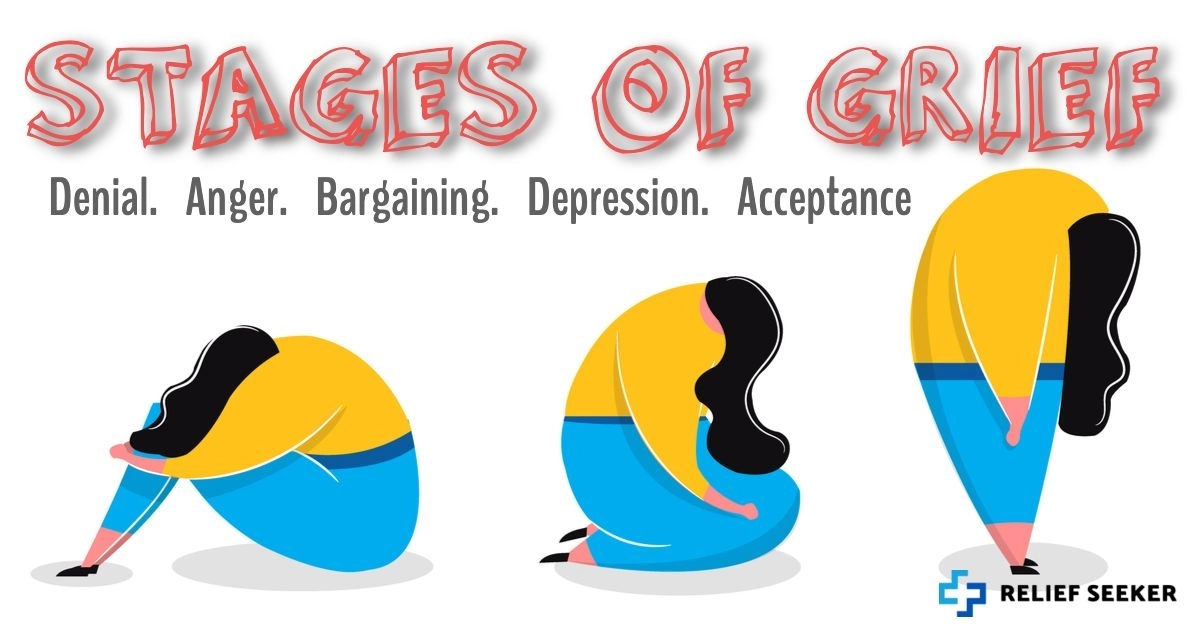What Is Grief?
Grief is a strong and sometimes overwhelming emotion for people. Whether their sadness stems from the loss of someone they love or a terminal diagnosis they receive, people might find themselves feeling numb or unable to live their day-to-day lives.
Grief is a very natural reaction to loss, is a personal experience, but isn’t linear; there aren’t set timelines. Sadly, we can’t tell Siri to schedule the stages of grief in our iPhone calendars. We all experience grief differently, and it can vary from the type of loss a person is experiencing.
Some examples of loss include:
The death of a loved one, such as a parent, child, romantic partner, or best friend
The loss of a job
The end of a relationship, either romantic or friendly
The loss of important material things, like family heirlooms or a wedding ring
The loss of independence through disability from an accident or traumatic experience
Grief and mourning can last for days, months, or even years. According to many experts, there is no real way to prepare for the stages of grief that come with loss, and unfortunately, many people don’t realize that they can’t control the process. Everyone grieves in their own way, but there are some common threads that connect the order of feelings a person experiences üduring the stages of grief.
Who Developed the Stages of Grief?
In the late 1960s, while working with terminally ill people, a psychiatrist named Elizabeth Kübler-Ross wrote a book called “On Death and Dying,” which referred to the way people experience grief and that these experiences could be divided into five stages. Most commonly known as the Kübler-Ross model, Elizabeth’s theory of grief became widely used amongst the medical community and has inspired others to write about their own ideas.
The five stages of grief might be the most common, but several others exist, including theories with seven stages and others with only two.
Five Stages of Grief
Grief happens in many ways, with not one person going through it the same. It is said that we may or may not experience the stages in the order they’re written, or if we’ll experience them at all. The stages were developed more as a guide to understanding the categories of how we experience grief rather than the order in which we go through the stages. For example, a person might begin coping after losing someone in the anger stage and remain there for months. No rule states everyone must go through the five stages in the same order.
The five stages of grief are:
Denial
Anger
Bargaining
Depression
Acceptance
Stage One: Denial
Most of us know that grief is and can be an overwhelming emotion, and for some, it’s often easier to cope with loss by pretending like nothing ever happened or that things aren’t going to change because of the loss. This is where denial comes in. Denying what just happened can give a person more time to let the news sink in, so there’s more room to begin to process it. Denial can be easier than facing reality and is used as a defense mechanism for numbing you to the pain of the situation.
However, denial does come with a price. As you move out of the denial stages, all the emotions you’ve been hiding will begin to rear their ugly heads, forcing you to confront the situation and realize the severity. The denial stage can be healing for people in the beginning but can be very difficult in the end as a person begins to feel the sadness they’ve been denying.
Some examples of the denial stage can include:
Death of a loved one: “My dad isn’t gone forever. He’s going to come through the door any minute.”
Breakup or divorce: “This will all be over tomorrow. They’re just upset.”
Terminal illness diagnoses: “This isn’t happening to me. They gave me the wrong results.”
Job loss: “My boss was overreacting. They’ll call me later when they come to their senses.”
Stage Two: Anger
Anger is a masking effect, which gives you the ability to hide many emotions and any pain you might be carrying. This stage commonly makes people direct their anger away from themselves and at other people, like your old boss, the person that died, your ex, or even inanimate objects.
Usually, when anger sets in, your brain knows that the object or person isn’t to blame, but your feelings are so intense that it’s the only way you’re able to behave at the moment. Anger has many faces that don’t always show up as rage but can mask itself more so in feelings of resentment, bitterness, or fury. Like we’ve said before, not everyone will experience each stage, and everyone experiences grief differently. Some will go through the anger stage, and others may not. Depending on the circumstance of the situation, or the person’s personality, the time spent in the anger stage can vary drastically.
The anger stage can be one of the most difficult as many people have a hard time showing their anger or are unsure of how to appropriately express themselves while in the anger stage. However, once you can think rationally about the situation and the anger begins to subside, you are then able to face all the emotions you’ve been putting on the back burner.
Some examples of the anger stage can include:
Death of a loved one: “If she didn’t love traveling so much, she wouldn’t have gotten on the plane that crashed.”
Breakup or divorce: “She’ll regret leaving me. I hate her!”
Terminal illness diagnoses: “I can’t believe God is punishing me in this way!”
Job loss: “I hated working there anyway; they’ll never make it.”
Stage Three: Bargaining
Grief can make us feel many things, but one feeling that is often very hard for people to deal with is vulnerability. When a person is vulnerable, they can feel like they’re showing weakness or can begin to act out of control. During grief, you can feel helpless and want to find a way to regain control of the situation. Some people even feel as though they could have changed the outcome during the bargaining stage. In this stage, people oftentimes create “what if” or “if only” statements so they can feel as though something might be different “if” this or that had happened instead of the reality.
People can also be found having conversations with their higher power about taking their pain away in return for something, such as spending more time at church or praying. This is a part of the bargaining stage that helps delay a person from feeling sad or hurt and typically only prolongs the time spent in this stage of grief.
Some examples of the bargaining stage can include:
Death of a loved one: “If only I’d gone to dinner that night, he wouldn’t be gone.”
Breakup or divorce: “If only I would have talked about my feelings more often, she would have stayed.”
Terminal illness diagnoses: “What if we had gone to the doctor earlier? Then we would have caught this cancer before it got this bad.”
Job loss: “If only I worked harder, they would have been more impressed with my performance.”
Stage Four: Depression
Like feelings of seasonal depression, this grief stage can feel very lonely as many people decide to isolate themselves. By this stage, most people are more in control of their emotions, and instead of masking the pain, they decide to embrace the loss to fully cope and come out the other side of the tunnel.
The depression stage of grief can be difficult and sometimes messy. Depression is often incredibly overwhelming and, if not dealt with properly, can be debilitating. You might even have feelings of confusion or a foggy brain.
Most people believe that depression is an inevitable feeling after loss, and as important as it is to work through, some people can find themselves stuck in this stage of grief. If you or someone you know is having a hard time getting out of the depression stage, it might be helpful to talk to your doctor or mental health professional or join a support group. A therapist or online therapist can help you crawl your way out of what might feel like a black hole.
Some examples of the depression stage can include:
Death of a loved one: “Why should I go on at all?”
Breakup or divorce: “I am nothing without him.”
Terminal illness diagnoses: “What did I do to deserve this death sentence?”
Job loss: “I will never find another job.”
Stage Five: Acceptance
It is important to know that even though you’ve gone through the stages of grief and have come out alive on the other side, acceptance doesn’t mean the pain or sadness will be gone. However, it means that you’re still breathing; you’ve accepted it and can now begin to see what your new normal looks like.
The new normal isn’t usually ideal, as you’ve had a major change in your life, but this stage of grief can be the most healing. And when we say this, we mean that by accepting the new reality, you’re making a conscious decision to continue moving forward. To continue living, allowing yourself to feel sad, and to know that there will be more good days than bad, which is OK.
Acceptance allows you to feel happy again and gives you a sense of purpose where we once felt despair and alone.
Some examples of the acceptance stage can include:
Death of a loved one: “I got to spend over 20 years with him and am so fortunate to have him forever in my memories.”
Breakup or divorce: “I am much better without the toxicity in my relationship.”
Terminal illness diagnoses: “I’ve gotten to do so many great things in my life, and now I have the opportunity to live out the rest of my days being thankful and not angry.”
Job loss: “I will find a new job that’s better suited for me.”
That’s a Wrap
Grief isn’t fun or rewarding. Grief is very personal, and if you take anything away from reading this article, it’s that grief is experienced differently by everyone. You can feel different every time you are faced with grief. You might only need a few days, or you may need several years to experience all the stages of grief.
Another important takeaway is that you’re not alone and shouldn’t have to handle your sadness solo. Talking to an online therapist, like a licensed professional from Talkspace, or joining an online support group through the Wisdo app are great places to start. Both can be great resources for working through your feelings.
If at any point you feel as though you can’t go on, please consider your options and call the National Suicide Prevention Hotline before making any rash decisions.
Related Article: Is Online Therapy Right For Me?


